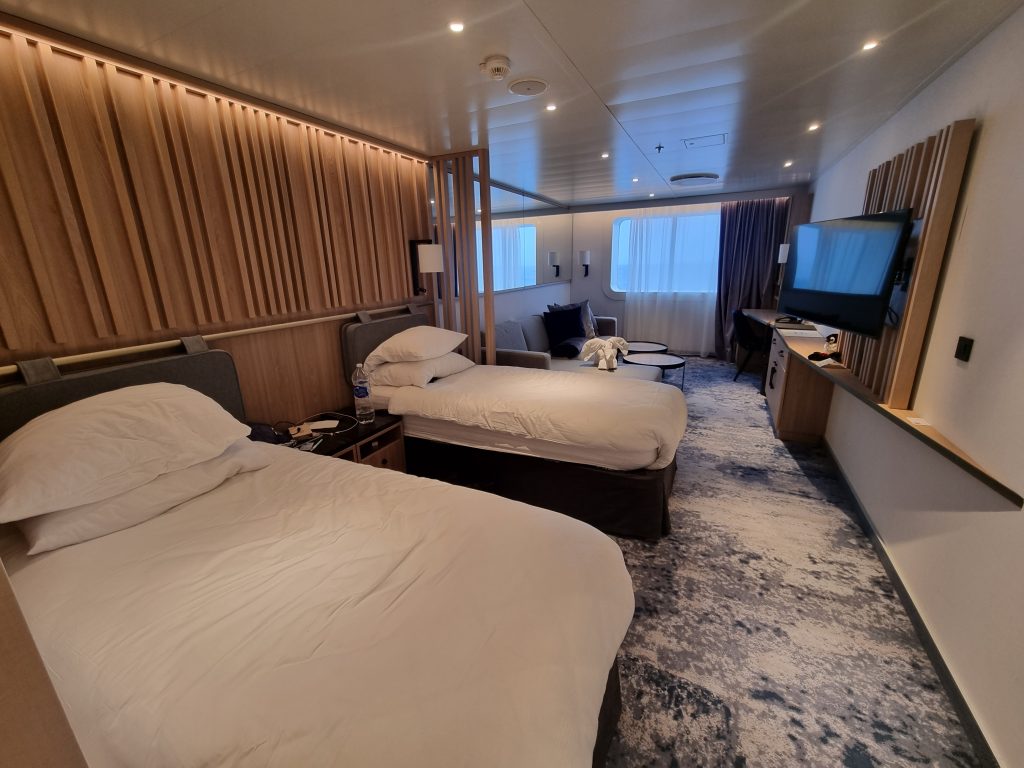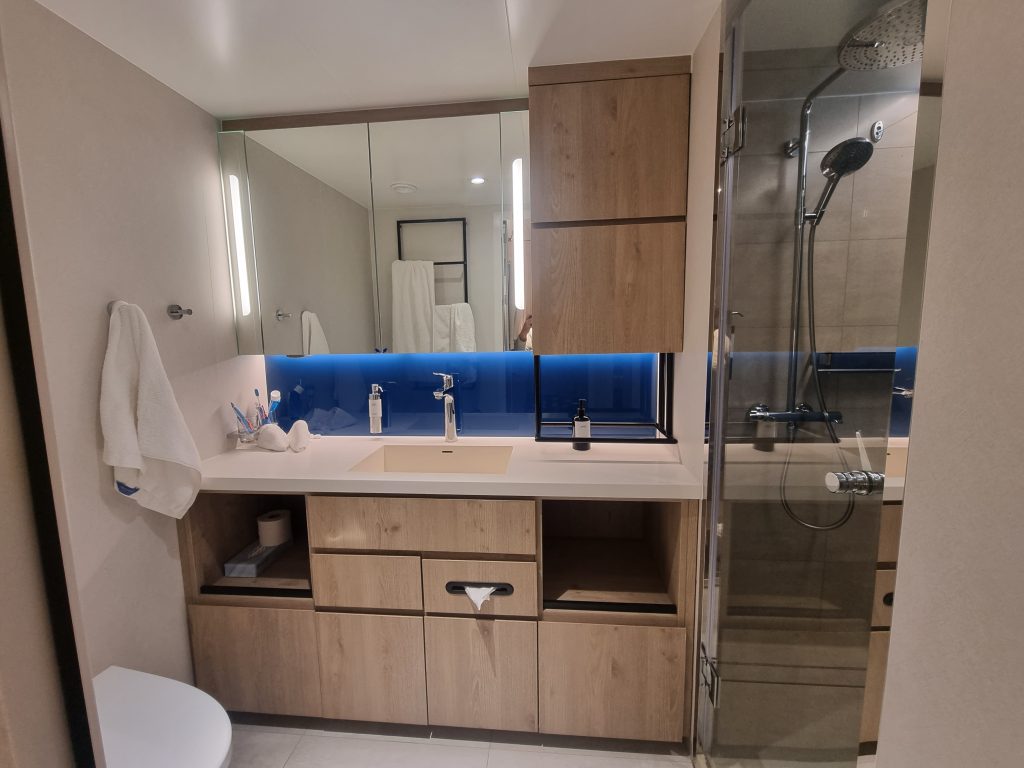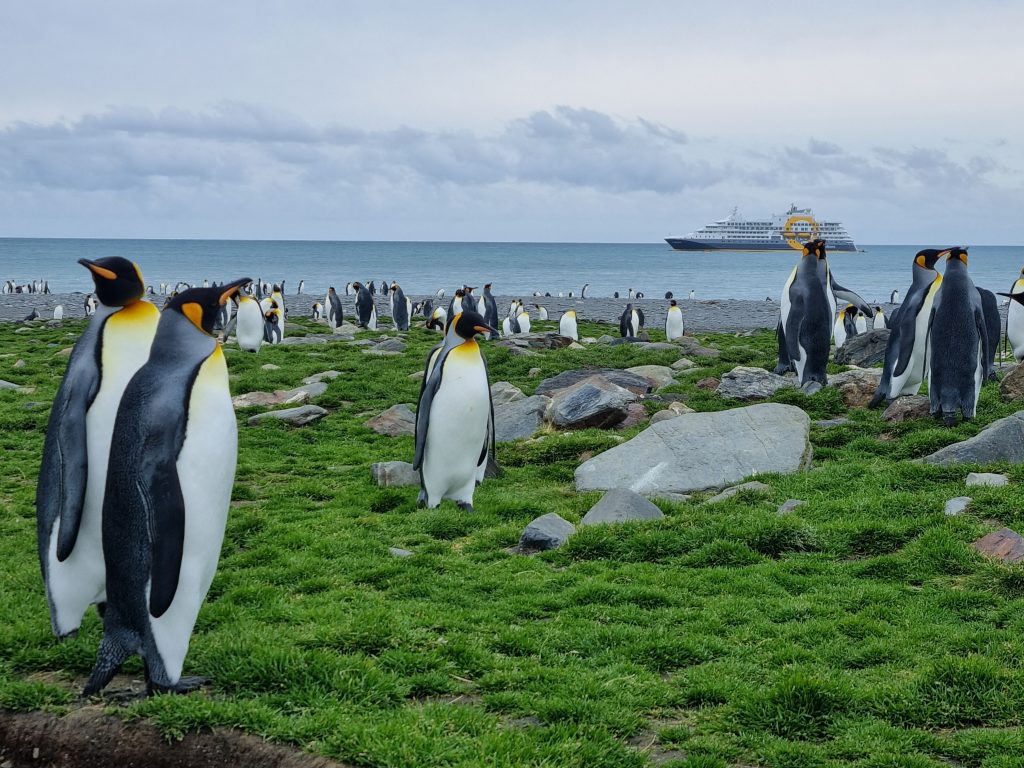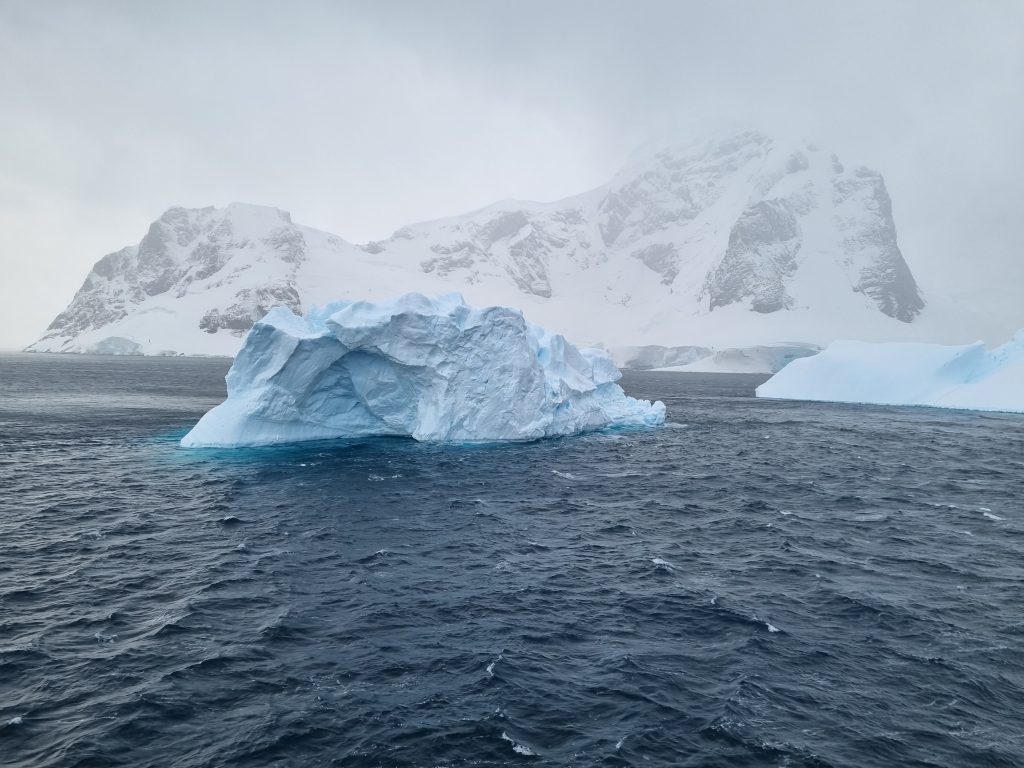By Tig Martin
Last month my friend Nikki and I joined the final voyage of the 22/23 Antarctic season aboard the Ultramarine expedition ship. Over sixteen incredible days, we sailed from Ushuaia to South Georgia, and on to the Antarctic Peninsula, before returning to Ushuaia across the Drake Passage. We wandered through king penguin colonies, immersed ourselves in polar history, and soared over spectacular landscapes by helicopter.
The Ship – Ultramarine
We began the journey with a night in Buenos Aires, before boarding an early morning charter flight to Ushuaia, along with a large group of fellow expeditioners. On arrival, the main group visited Tierra del Fuego National Park while we took a tour to explore what this amazing ship has to offer.
Launched just two years ago, the custom-built Ultramarine is perfectly designed for exploring the polar regions. The ship is set up to maximise expedition opportunities while also offering comfort and a touch of luxury to its guests. There’s a fully equipped gym, steam room and sauna, as well as luxury spa with a range of reasonably priced massages and treatments. We were kept well fed with a wide variety of options across two restaurants, and stellar service from the exceptional hotel team.
We were fortunate not to face very large seas. We encountered 5m swell at most, but the Ultramarine is incredibly stable. Both Nikki and I were a little worried about the potential for seasickness on the long ocean crossing, however neither of us were ill and no other passengers appeared to suffer either.
All the cabins on board are spacious and comfortable, with large wardrobes, a lounge area and a roomy ensuite, featuring waterfall shower and heated floor. The SmartTV allows you to watch presentations from your cabin if you wish or relax with some entertainment from the large library of free TV and movies. The higher category cabins offer larger living areas as well as balconies and bathtubs. We stayed in the entry-level Explorer Suite and were exceptionally comfortable.
For those looking to take it easy, the Panorama lounge, with its floor to ceiling windows, is the perfect spot to watch the world float by over a coffee or gin and tonic. The bar was quite reasonably priced, with a large menu ranging from US$6-$10/drink. The lounge has a well stocked polar library and also features a duplicate bridge setup showing all the dials and radar the ship’s crew use to navigate.
Although we enjoyed these luxurious touches, delivering spectacular expedition travel remains Quark Expeditions’ principal focus. With 20 zodiacs and 35 expedition staff, we took advantage of every opportunity. All 199 passengers can disembark at the same time to enjoy landings or zodiac cruises. In practice this means there’s rarely a moment when you are anxiously sitting around waiting for others to finish their excursion so you can have your turn. There are multiple adventure activities available, kayaking (prebook only), paddling and stand up paddle boarding. To top it all off the Ultramarine also houses two 7-seater helicopters on Deck 8, providing an entirely new perspective of Antarctica! Flightseeing is included in the voyage, and the team take advantage of every opportunity to get in the air.
Things happen quickly on expedition. One moment we were enjoying the views in the Panorama lounge, the next we were boarding zodiacs and heading off in search of humpback whales. That’s not to say it was rushed. The expedition team is a well-oiled machine. We were kept well informed of the plan as it evolved according to weather and water conditions. Once the crew had assessed the area, we were called down by expedition groups and boarded zodiacs quickly and efficiently. The zodiac pontoon at the rear of the ship was very stable and, with the assistance of the ship’s crew, made boarding a breeze.
Sea Days
Nikki and I were well equipped with distractions for the sea days – we had books, games, face masks, and hard drives of movies and tv shows. Bar one book, we used none of it – and we were never bored. During sea days there were 2-3 presentations from the expedition crew. From albatross to whales, and Captain Cook to Shackleton, we learned a lot. The presenters were all charismatic and engaging, sharing fascinating information but keeping it light and easy to follow. I never thought I would eagerly anticipate the next bird lecture, but self-confessed Bird Nerd Noah was funny and his passion for ornithology was contagious. Our resident historian Ross brought the tumultuous history of polar exploration to life with the perfect mix of information and comedy. Colin, Ultramarine’s geologist, explained the different between a glacier and an ice shelf, as well as showing us how the whole Antarctic region came to be.
The sea days gave us plenty of time to get to know the ship and the expedition crew on board. In between lectures and activities, we enjoyed spending time out on the wraparound deck. The eagle-eyed expedition team were always around to lend a helping hand in spotting albatross, whales and other animals, and were keen to answer all our questions. When we got too cold we would retreat inside to the Panorama lounge and keep watch from the floor to ceiling windows.
South Georgia
South Georgia is one of the most remote islands in the world. There is only one way to get there and that’s to sail. It takes 3 and half days to sail from Ushuaia to the westernmost point of South Georgia. I thoroughly enjoyed our sea days, not only were we constantly busy with activities, but it reinforced the remoteness of our destination, and when we finally arrived, how fortunate we were to be able to visit. The weather on South Georgia can be unpredictable and extreme. The high glaciated mountains mean that the bays and inlets below can be battered by katabatic winds (Colin taught us about them), making landings a challenge. Our expedition leader Ali, alongside the captain, worked tirelessly to find protected areas and get us off the ship safely.
Fortuna Bay
Our first landing was at the aptly named Fortuna Bay, home to fur seals and a large king penguin colony. Our group began with a zodiac cruise along the shoreline to see the fur seals. Thousands of pups lined the shore, squabbling with each other as they climbed rocks and dove into the water. Many pups spotted us and swam over, inquisitive of the new arrivals. We were surprised by how fearless they were, coming right up to the zodiacs to look at us. The last few remaining elephant seals lazed on the black sands, enjoying a final rest before heading back into the ocean for the winter.
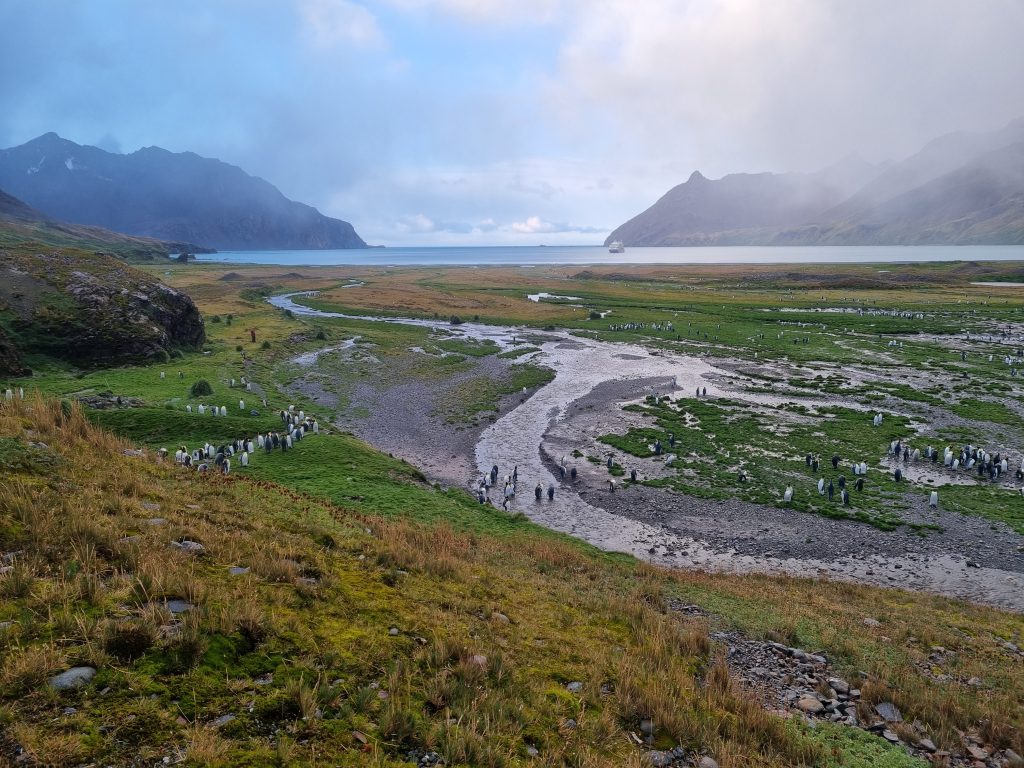
After our zodiac cruise we made our way to the landing point to visit the colony. We had spotted a couple of king penguins among the fur seals on the shoreline, and were ready to get closer. As we pulled in to land, a group of around 20 king penguins were standing on the shore, like a welcoming committee ready to receive us. Unconcerned about the logistics of zodiac landings, they crowded in closer as we disembarked. They escorted us up the sand, waddling along to our meeting point where were given some guidelines and a return time. After that, we were free to wander.
The expedition team had marked out a general path to the colony and were positioned regularly along the route to help or answer questions, however we were given the time to take in our surroundings at our own pace. The general rule is to leave 5m between you and any wildlife, however, despite our best efforts, king penguins are rogue rulebreakers. It became almost impossible to keep away from them. They continued to waddle over, slapping their bellies and inspecting us. The fur seal pups were no better, lolloping towards us like over-excited puppies. The mothers depart the beach in late February, never to return to them. It takes a few weeks for the pups come to terms with their situation before heading out into the ocean. During that time they appear to think any visitor, seal, human or otherwise, has come to give them food. Much like a small puppy, a strong ‘No!’ kept them at bay.

Fortuna Bay 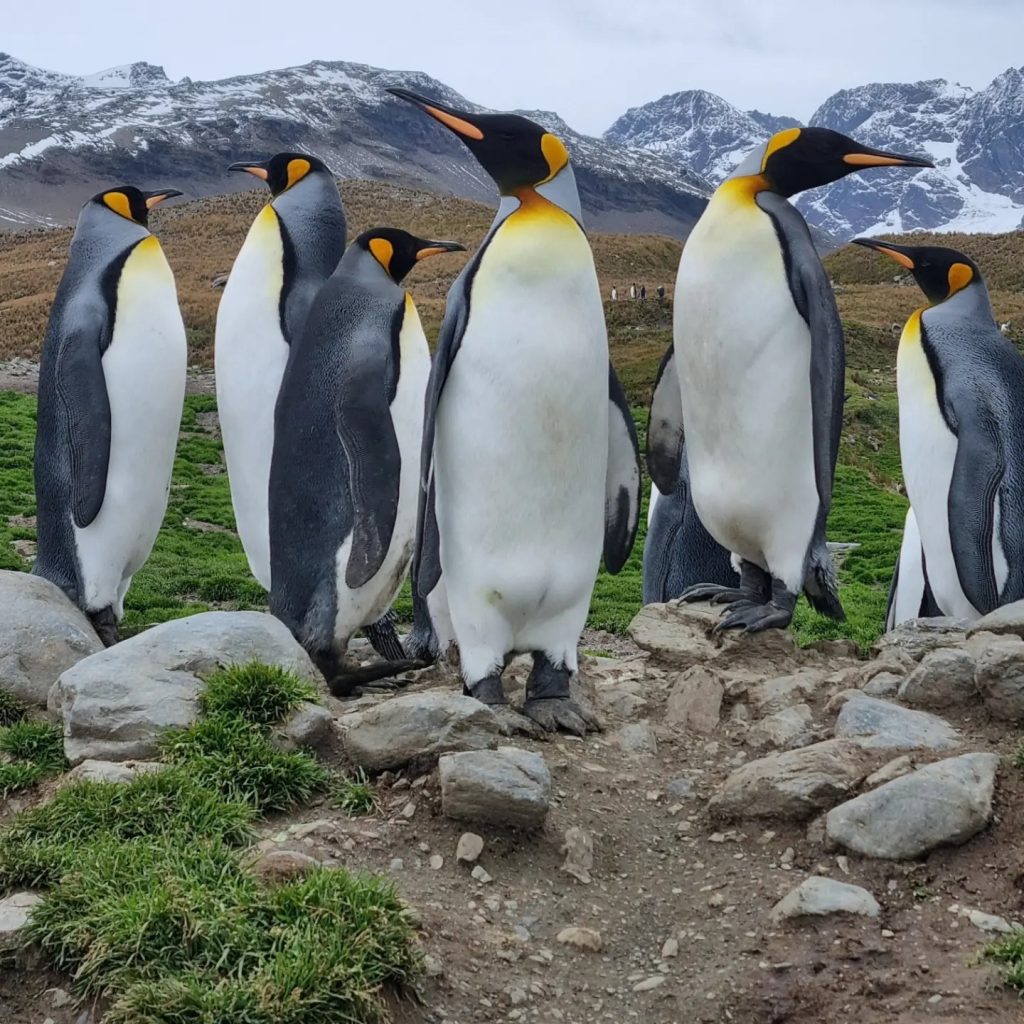
Fortuna Bay
While the animals were incredible, the environment in which they live is equally stunning. Huge snow topped mountains rise up out of the sea, with sheer cliffs decorated with a colourful array of moss and lichen. The valleys are soft and green, dotted with tussock grass, rocky outcrops and glacial streams. During our visit an afternoon fog descended, enveloping the bay in a mystical dreamlike haze. Nikki and I wandered across the sweeping valley with silly big grins on our faces, glancing over every so often to laugh and remark how unbelievable it all was. This would soon prove to be our default setting for the whole trip.
Grytviken
We awoke the following morning, unsure what the weather would deliver. I drew back the curtain in our cabin and was greeted by bright blue skies and the towering King Edward Point sitting right outside our window. The water was glassy, the air crisp and the sunlight bounced off the glacier-topped mountains. We began our visit with a short presentation from the South Georgia Heritage Trust, hearing about the biosecurity regulations and their successful efforts to eradicate rats from the island. Before every landing in South Georgia and on the Peninsula, our boots and outerwear were inspected for mud, seeds and grass, ensuring we didn’t impact the delicate ecosystem.
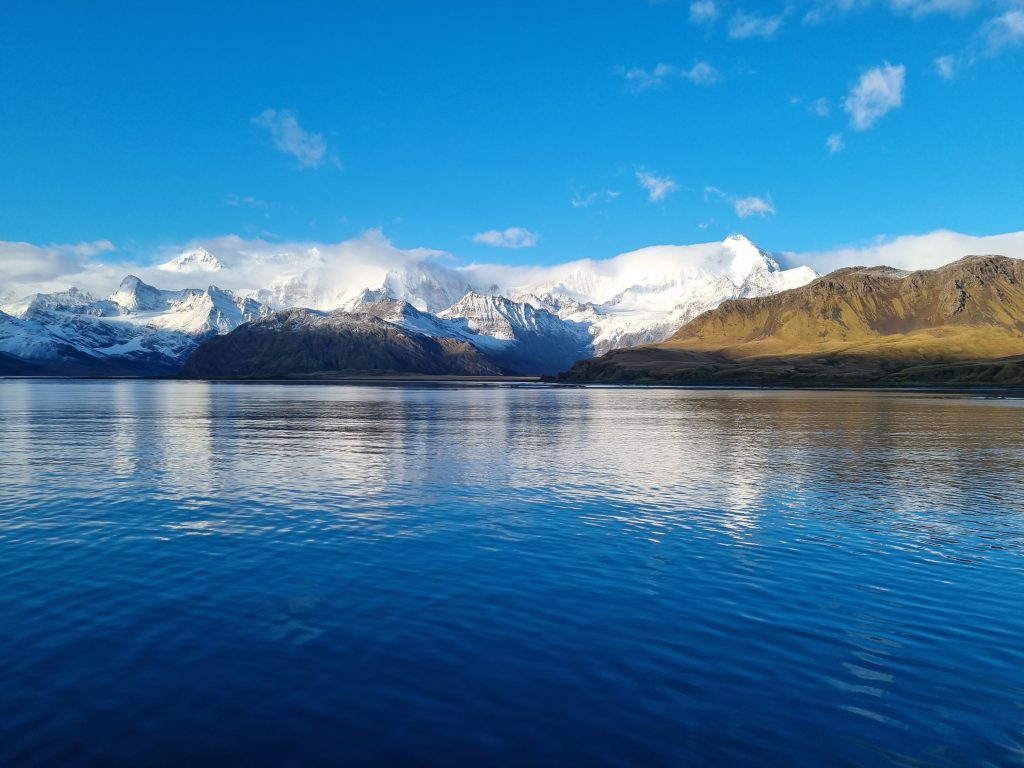
King Edward Cove 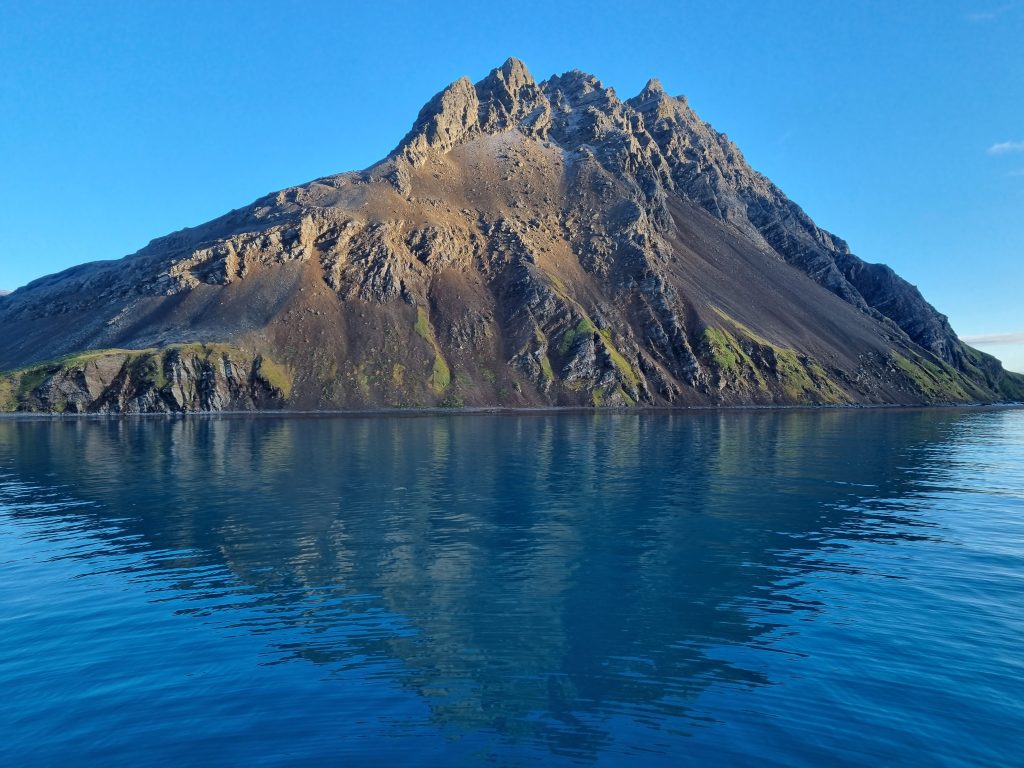
King Edward Point
We were given three hours to explore Grytviken. The more adventurous types walked to see an old helicopter crash site, others hiked a to a nearby lookout. Nikki and I joined Ross at Shackleton’s grave for a rousing whiskey toast. We learned that the ashes of Frank Wild, Shackleton’s second in command, are also buried in the cemetery. His family had them interred beside Shackleton in 2011 so he would once again be his ‘right hand man’.

Zodiac embarkation 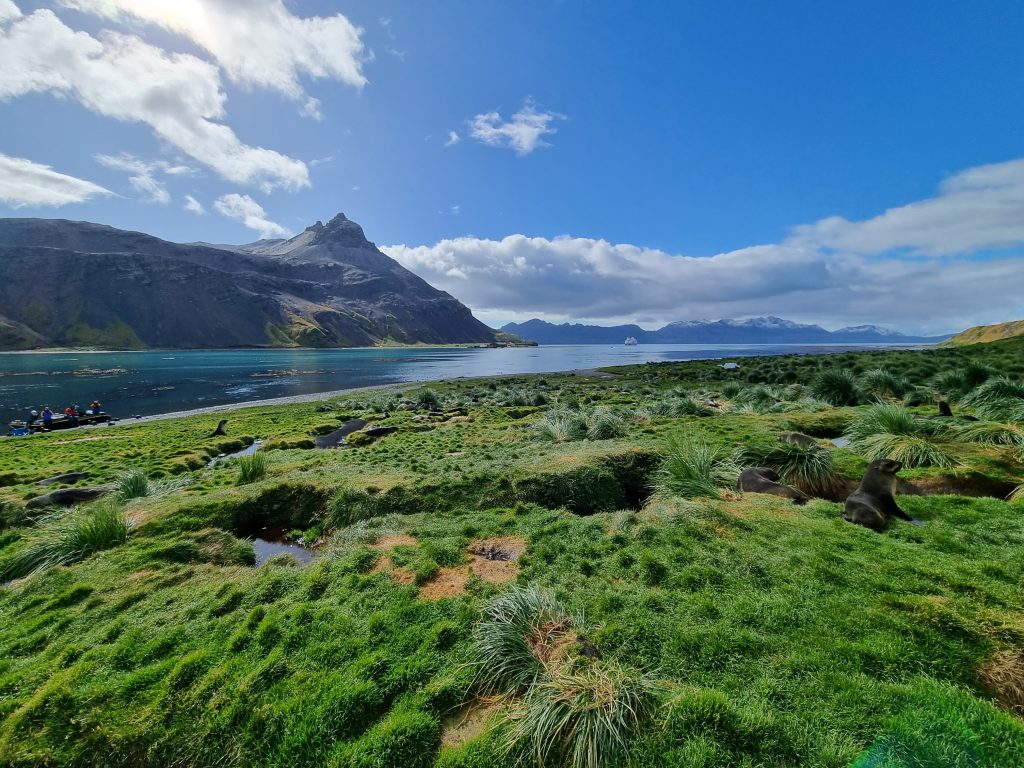
View from Shackleton’s Grave 
Whiskey toast at Shackleton’s Grave
Next we made our way over to the whaling station for a guided tour. Along the way we passed hundreds of fur seal pups lounging in the tussock grass and swimming in streams. It is strange to think that less than a century ago, this was a place of danger for fur seals and whales, and now they have reclaimed it as their own. We heard about the whalers who lived on South Georgia, and the morbid efficiency of their hunting and processing techniques – the station was capable of dissecting a blue whale in just 20 minutes. The towering machinery has long since fallen silent and now sits rusting in the sea air. The shore is littered with ship wrecks and whale bones, both of which the fur seals use as day beds to warm themselves in the sun.
The station is home to an official British post office where you can send a postcard that will arrive well after you get home, as well as an informative museum featuring a full-sized replica of the James Caird boat that Shackleton and his crew sailed from Elephant Island.

Grytviken church 
Grytviken fur seal pups 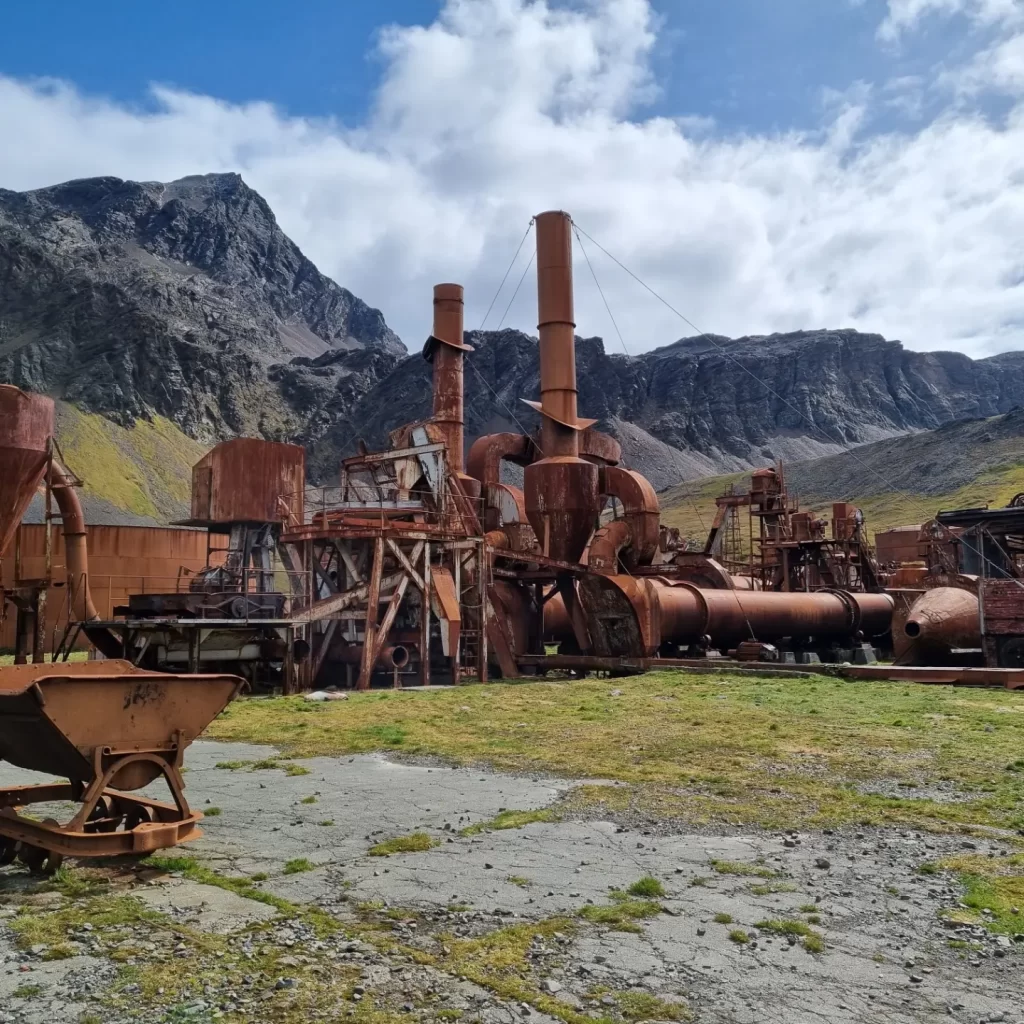
Grytviken Whaling Station
St Andrew’s Bay
We left Grytviken and travelled further down the coast hoping that the wind and sea would allow us to land at St Andrew’s Bay, the largest king penguin colony in the world with an estimated 170,000 breeding pairs. The favourable weather conditions continued and we disembarked. Once again we were greeted on the shore by inquisitive penguins, as well as some sleeping elephant seals who were rather indifferent to our arrival.
We were free to walk to the main colony viewpoint along with our penguin escorts. We noticed there were often groups of three penguins standing together as though in conversation, they would stare at each other until one would suddenly whack another with its wing for no apparent reason.
Climbing a small hill we were taken aback by the scale of the scene. Tens of thousands of penguins milling around, as hungry skua birds tried their luck at snatching a fledgling chick. Some pairs were carefully cradling eggs on their feet, making sure to keep them warm with their feathers. Other pairs had fluffy brown chicks, some already too big to fit between their parents’ legs, but not confident enough to leave their side just yet.
Drygalski Fjord
After a morning spent cruising around Royal Bay watching a leopard seal hunt macaroni penguins, we continued south before sailing down the breathtaking Drygalski fjord. The narrow fjord is bordered by imposing mountains with bright blue glaciers tumbling down to the turquoise water. Everyone made their way to the helideck for music, dancing and bubbles to celebrate our unforgettable time in South Georgia.
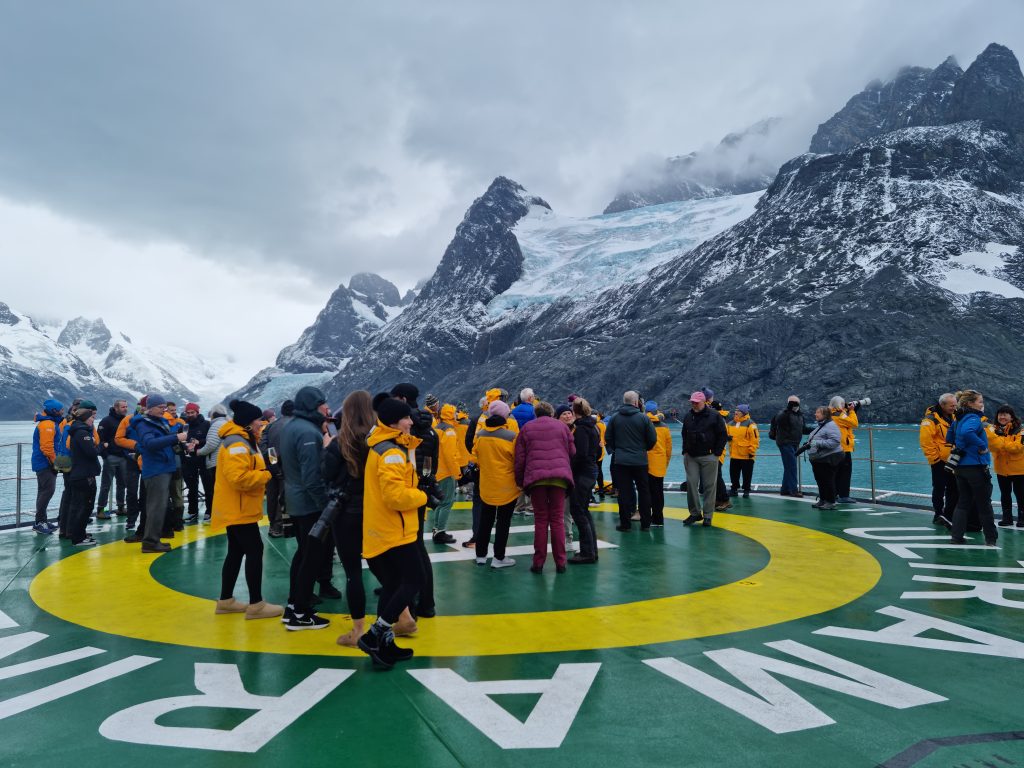
Bubbles on the Helideck to farewell South Georgia 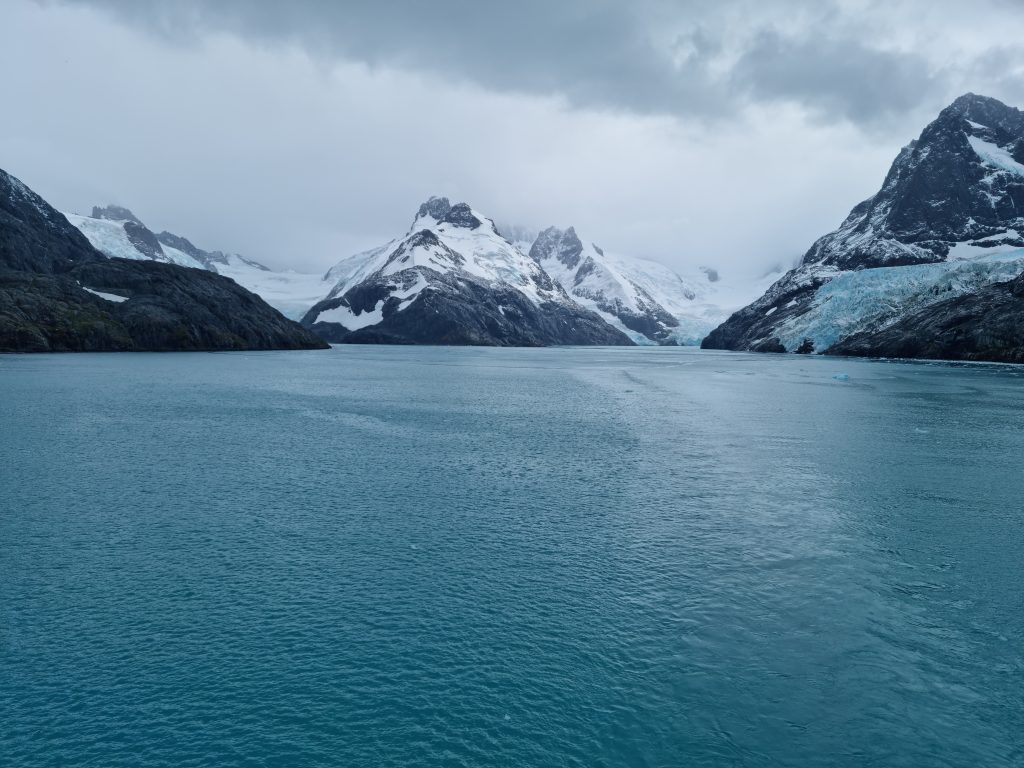
Drygalski Fjord
Antarctic Peninsula
After two days sailing across the Scotia Sea, with plenty of lectures and entertainment, we arrived at the Antarctic Peninsula. We attempted to land at Elephant Island, where Shackleton’s crew waited for rescue after overwintering on the pack ice. However, the weather didn’t allow it, so we headed further down the Peninsula.
The Antarctic landscape is difficult to put into words. The mountains were larger, the icebergs were bigger and bluer than I expected. Every now and again I would be struck by the sheer immensity of the environment – everything was gigantic. Every surface is covered by thick ice. Photographs don’t do it justice (at least mine don’t!). Capturing the nuanced beauty of Antarctica on camera was difficult. The subtle changes in colour in the ice, the shadows and textures were spectacular and you could sit for hours contemplating the landscape before you. It was captivating.
Wilhelmina Bay
One afternoon, we were quietly watching the icebergs drift by when everyone jumped into action. Within the hour we were on a zodiac watching a pod of 3 humpback whales feeding alongside us. Our expedition guide Michelle gave us plenty of tips so we didn’t miss a moment. We followed them for over an hour, seeing them gulping up huge swathes of water multiple times before diving down deep, giving us a great look at their tail flukes. The whales were so much bigger than I anticipated, the video doesn’t do it justice, they are enormous.
After our whale watching tour we returned, breathless, to the ship and were immediately sent up to ready for the helicopters. I had never been in a helicopter before this trip. Now I have been in a helicopter… in Antarctica… that took off and landed from the top deck of a ship. Tick tick tick. The helicopters are definitely a huge selling point of the Ultramarine. A very small number of people ever have the privilege to see Antarctica, and an even smaller number see it from the sky. It gives you a totally different perspective. You can see down the crevasses of the glaciers and ice shelves, see the multitude of blues and whites, and get an idea of the immense scale of the Continent.
Landing back on the ship, we were buzzing with excitement about how much had happened in just 3 hours.
Van Beneden
The following morning, we disembarked early for what was many passengers’ bucket list event – landing on the Antarctic Continent. Once again, we were treated to a whale show, as another pod of humpbacks fed in the shallow waters beside a chinstrap penguin colony. Some curious chinstraps dove into the water to come and investigate, leaping in the zodiac wake. We spotted a couple of shy Weddell seals, their big brown eyes peering out from behind the floating glacial ice. The clouds lifted to reveal stunning snow-covered mountains and the water was mirror-like as we set foot on the Continent for the first time.

Landing on my 7th Continent 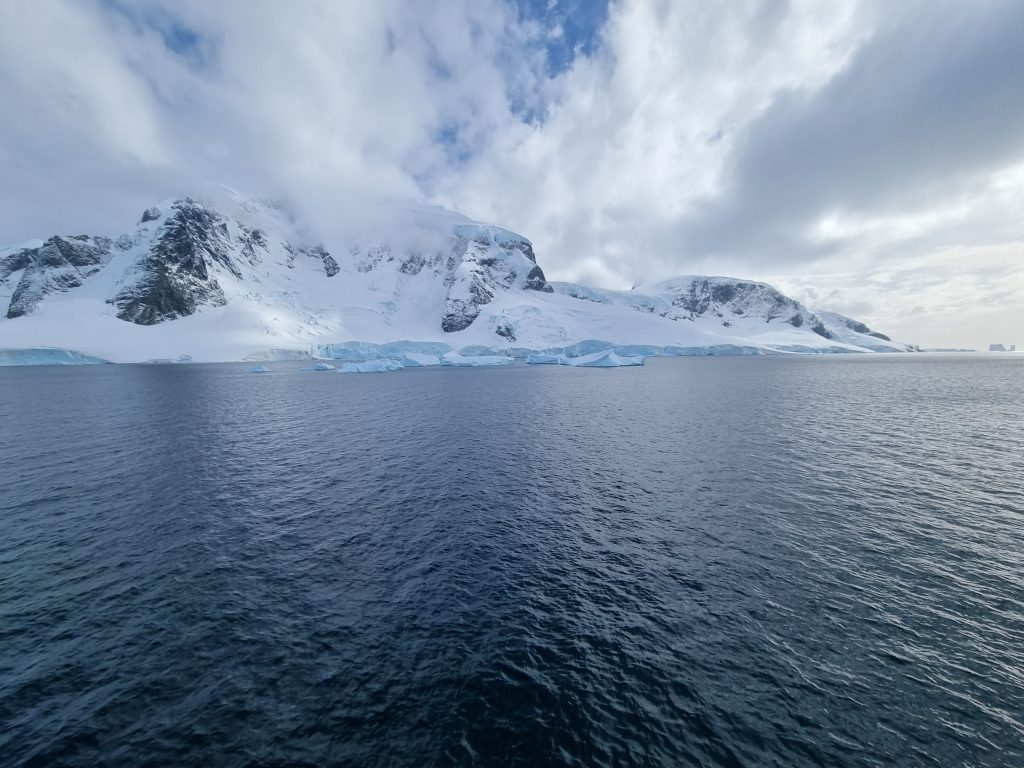
We finished off our time on the Peninsula with the spectacle of the Polar Plunge. Sixty eight hardy passengers braved the icy waters and voluntarily threw themselves off the zodiac pontoon, as we watched on from the rear deck, in the warmth of our parkas. As we made our way back up the Peninsula, the wildlife encounters continued, with whale sightings and even had a pod of orcas sidling up to the ship, much to the delight of everyone on board. We were treated to a show from a pod of hourglass dolphins, leaping in the ship’s wake as we crossed the Drake Passage. Fortunately we once again encountered favourable seas on our crossing, allowing us to celebrate our remarkable journey by partying and dancing late into the night.
Arriving into Ushuaia in the early morning there was a palpable sense of sadness among the group. The trip of a lifetime – one that many had waited years to experience after covid delays – was over. The Ultramarine felt like home and no one wanted to go. As we said our farewells on the dock there seemed to be one recurring statement – ‘I’m definitely going to the Arctic next!’
Surprises and Tips
The Cold: I loathe being cold and I feel it keenly. I was quite concerned before my trip that I would freeze the whole time. Despite reassurances from colleagues that I would be fine, I had many, many layers, some may say too many layers. On our first landing at Fortuna Bay I was wearing no less than 8 layers. Excessive? Yes. I had to stop and peel off some layers because I was overheating. The temperature hovered around 2 degrees during our trip, and while the wind chill made it feel colder, it was nothing gloves and the complimentary parka couldn’t fend off. The muck boots provided are thick and warm, I wore two pairs of merino socks and was toasty warm. I suggest investing in warm merino base layers and a good down puffer jacket but beyond that don’t worry too much about getting all the gear.
Essential Reading: I spent some time during our sea days reading Alfred Lansing’s Endurance, an account of Shackleton’s remarkable story of survival. I had intended to finish it before the trip, but as tends to happen, other things got in the way. In the end I was glad to read it on board. It was quite poignant, and often confronting, to read of the hardship and suffering endured by those incredible men, all whilst retracing their route – albeit in significantly more comfortable fashion. Shackleton and five of his crew sailed aboard the 6.9m James Caird tender from Elephant Island to South Georgia in just 17 days, an unrivalled feat of navigation and resilience. It is even more impressive when you consider that in 2023, with favourable seas, that same journey still took the 127m custom-built Ultramarine two and half days.
Seasickness: I was a bit apprehensive about seasickness. Everyone hears about the Drake Shake. With quite a few sea days I was worried I would be ill. I needn’t have worried. Neither Nikki nor I were sick during the trip. We took preventative seasickness tablets on sea days, but on landing days we didn’t bother. We would definitely feel the ship moving however the Ultramarine is so stable pretty much everyone onboard was ok.
Photography: Do you need a DSLR camera and huge lens to take great photos? No. All my photos were taken on my Samsung S21. South Georgia in particular is an incredibly easy place to take amazing photos. The contrast between the king penguins, the blue water and green grass is a photographer’s dream. The Peninsula presents a greater challenge, with all that white snow and ice it can be tricky to capture the scale and depth of what you are seeing. A flash camera would definitely come in handy there, so long as you know how to use it. That being said, there’s an official photographer onboard (there was a presentation on maximising your camera/phone potential) and passengers are encouraged to contribute their best photos to the end of trip slideshow as well. After the voyage you receive a link to the online database of images, so you won’t miss out. If you are going to use your phone camera, make sure you get some phone touch-enabled gloves so you don’t freeze!
Wifi: I wasn’t expecting wifi at all, let alone free wifi! There’s a paid version that is faster however we just used the free option and it was great. We were able to send whatsapp messages and upload images to instagram and facebook. It didn’t work everywhere but then what more do you expect from a ship in the Scotia Sea?
Final Thoughts
In my 5 years working at Eclipse Travel, part of my role was uploading the expedition information that appears on the website. I have read hundreds of Antarctic itineraries and stared longingly at amazing wildlife and landscapes images of Antarctica and South Georgia. I was keen to one day travel to these incredible places and see it for myself – huge mountains, noisy penguins, immense icebergs, and massive whales. I thought I was prepared but I was not.
Without a hint of hyperbole, Antarctica and South Georgia literally took my breath away. It exceeded all my expectations. I have run out of superlatives to describe the experience and since returning have struggled to articulate how spectacular it was. I’ve travelled to some incredible places but this expedition is one of the best things I’ve done in my life.

